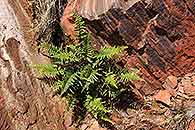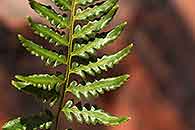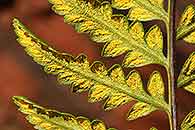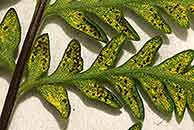Pityrogramma calomelanos (L.) Link var. aureoflava (Hook.) Weath. ex L.H. Bailey
Synonyms |
Gymnogramma calomelanos (L.) Kaulf. var. aureoflava Hook. |
|---|---|
Common name |
|
Description |
Rhizome erect to shortly creeping, up to 10 mm in diameter; scales light brown, linear, up to 4 mm long, margins entire. Fronds tufted, arching, firmly herbaceous. Stipe 6-36 cm long, black to chestnut brown, shiny smooth with few scales at the base. Lamina 14-37 × 7-14 cm, ovate to lanceolate in outline, 2- to 3-pinnatifid, long tapering to the apex. Pinnae oblong-lanceolate to narrowly lanceolate, pinnatifid to varying degree, apices acute, margins shallowly toothed and inrolled in dried material, dark green above and covered with a yellow powder below, glabrous on both surfaces. Rhachis black to chestnut brown, shiny, glabrous. Sori about 3 mm long, situated along the veins in the outer half of the lamina between the costule and margin, often difficult to see because of the yellow powder; exindusiate. |
Notes | First record for Zimbabwe: PB2089!!!
|
Derivation | calomelanos: beautifully black, referring to the colour of stipe and rhachis; aureoflava: golden yellow, the undersides of the lamina are covered with yellow powder. |
Habitat | In crack of rocks of artificial cliff caused by old mining activity, in full sun |
Distribution worldwide | Native of South and Central America but naturalised in DRC, South Africa, Swaziland, Zambia, Comoro Islands, Mauritius, Australia. Now also found in Zimbabwe. |
Distribution in Africa |
Dem. Republic of Congo, South Africa, Swaziland, Zambia, Zimbabwe. |
Growth form |
Lithophytic, terrestrial. |
Literature |
|






